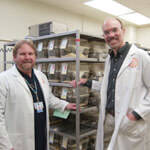
San Antonio (May 18, 2004) – The University of Texas Health Science Center at San Antonio has received a $2.5 million grant for a National Institute on Aging (NIA) Intervention Testing Center, one of three such U.S. centers established by the NIA to test potential therapeutic interventions to slow the aging process.
The new center, which is part of the Health Science Center’s Sam and Ann Barshop Center for Longevity and Aging Studies, will test compounds that may slow the aging process and extend life span or “health span” – the continuation of good health throughout life. The San Antonio Aging Intervention Testing Center will interact closely with the two other NIA-designated centers at the University of Michigan and Jackson Laboratories, Bar Harbor, Maine.
The San Antonio center is headed by Randy Strong, Ph.D., associate professor of pharmacology at the Health Science Center and research career scientist with the South Texas Veterans Health Care System, and Jim Nelson, Ph.D., professor of physiology at the Health Science Center.
“Ten years ago, the only intervention known to increase life span in mammals was caloric restriction,” Dr. Strong said. “Since that time, rapid advances in gene technology have led to the discovery of a number of genetic manipulations or mutations that extend life span in both invertebrates (flies and worms) and mammals (mice and rats).
“In addition, epidemiological and clinical studies point to anti-inflammatory medications as having positive effects in preventing cancer and in delaying the progression of neurodegenerative diseases, and these medications are under clinical trials in Alzheimer’s disease and chemoprevention studies of colorectal cancer. Thus, a number of therapeutic targets are now identified and that is why the NIA funded a program to test potential interventions in aging processes. We are honored to be part of this new program.”
Dr. Strong said the genetic alterations studied by scientists have included manipulations of the insulin-like growth factor 1 (IGF-1) and insulin receptor genes; mutations in a gene that governs growth hormone and targeted deletion of the growth hormone receptor gene; targeted deletion of signaling molecules in the IGF-1 and insulin signaling pathways; and engineering animals to make high levels of anti-oxidant enzyme.
The first four interventions to be tested starting this summer are anti-oxidant and anti-inflammatory compounds. Four to five studies will be added each year to study other interventions.
“Biomedical aging research is in an exciting phase of rapid growth,” Dr. Nelson said. “The growing number of genes that are being found to play a role in aging provides a growing number of targets for drug therapy and interventions suitable for our center to test. My own studies, which show that anti-inflammatory mechanisms are associated with the longevity effects of calorie restriction, support the anti-inflammatory interventions being undertaken in these trials.”
Barshop Center Director Arlan Richardson, Ph.D., said, “This Intervention Testing Center will contribute to the Barshop Center’s emp

